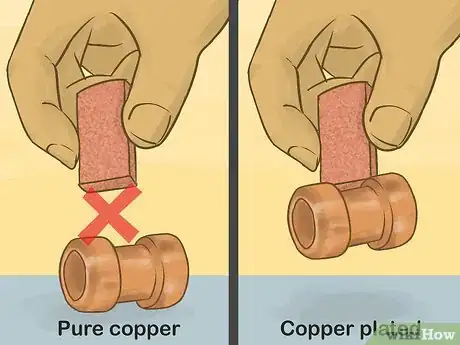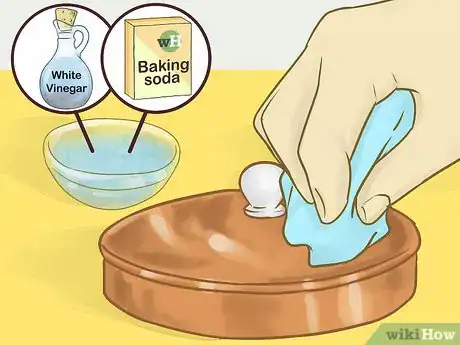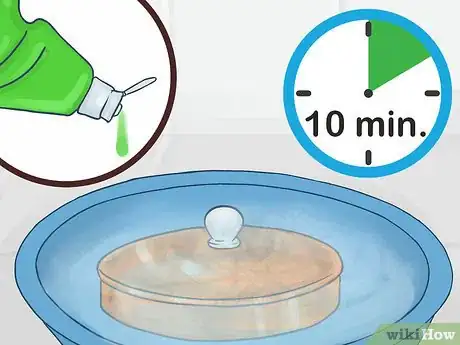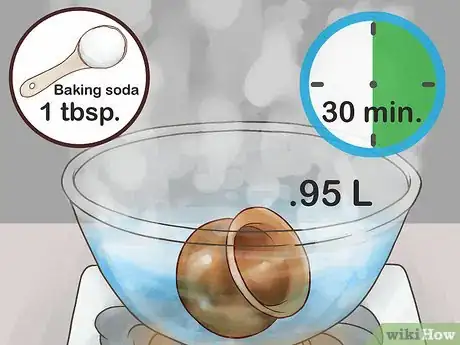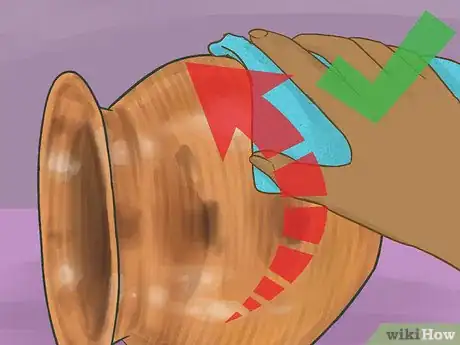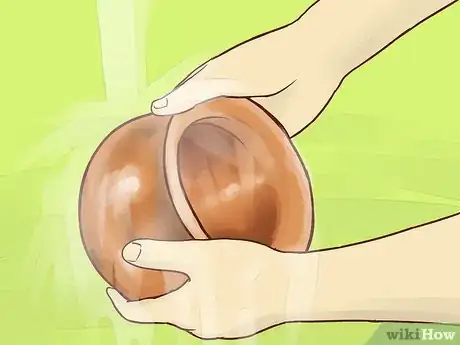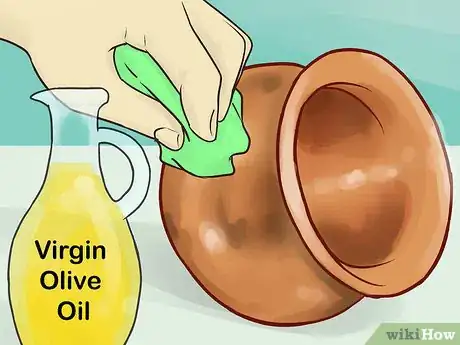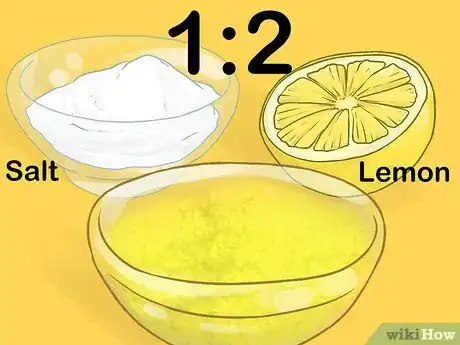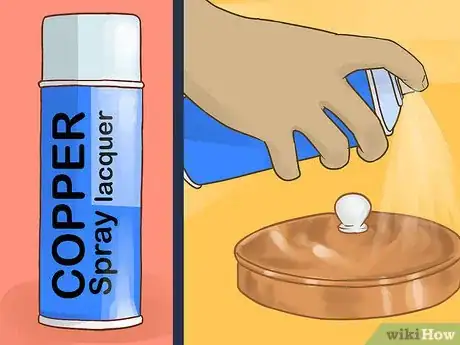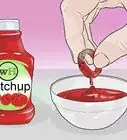This article was co-authored by Alicia Sokolowski. Alicia Sokolowski is a Green Cleaning Specialist and the President and co-CEO of AspenClean, a green cleaning company in Vancouver, British Columbia. With over 17 years of experience, Alicia specializes in creating a healthier, green alternative to chemical-based cleaning products and services. AspenClean develops and manufactures its own line of 100% Natural, EcoCert® certified, and EWG verified™ cleaning products. AspenClean’s glass cleaner was voted Parent’s Green Pick 2020 by readers of the Parents’ magazine. Alicia holds a CPA designation and a Bachelor’s degree in Commerce and Finance from the University of Toronto.
wikiHow marks an article as reader-approved once it receives enough positive feedback. In this case, 100% of readers who voted found the article helpful, earning it our reader-approved status.
This article has been viewed 92,042 times.
Exposure to air can cause your copper to oxidize and tarnish with a blue-green patina. Many common cleaners leave this patina untouched. Prep to remove oxidation by verifying the metal item is really copper and checking for the presence of lacquer. Remove oxidation from copper with a paste made of white vinegar and salt. Prevent oxidation with a thin coat of virgin olive oil or lacquer.
Steps
Preparing the Surface
-
1Verify the metal is copper. Position a magnet close to the copper. If the magnet sticks to the metal, the item you are cleaning is only copper plated. If the magnet doesn't react, your item is likely copper. Plated copper generally needs to be treated more gently than pure copper.
-
2Check for the presence of lacquer. Lacquer is frequently applied to copper to prevent tarnish. However, this can crack and cause copper to tarnish unevenly. Use a cloth to dab a little white vinegar and baking soda on an out-of-sight place on the metal. Metal that brightens is lacquer-free.[1]Advertisement
-
3Wash the copper in warm, soapy water. Mineral deposits and debris are likely contributing to the tarnished appearance of your copper. Soak copper items in warm water with a small amount of gentle dish soap for about 10 minutes. Rinse the metal with water and dry it with a microfiber cloth.
- Do not submerge copper plated items in water. Instead, use a microfiber cloth dampened with water. Add a few drops of mild dish soap. Wipe the copper clean and dry it with a fresh microfiber cloth.
- Copper plated items should not be cleaned with normal methods. Buff these items with a copper polish after wiping it clean and drying it.[2]
-
4Remove lacquer by boiling copper in baking soda if desired. Cracked lacquer can result in difficult to clean tarnish, which will be easier remove after de-lacquering. Add water to a large pot in quarts (.95 L) until there is enough to completely submerge the copper. For each quart of water add a tablespoon (15 ml) of baking soda. Bring this to a boil and boil the copper for 30 minutes.
- Large items can be boiled in this fashion in sections. It may be easiest to use a lacquer remover or acetone to remove lacquer from large items.
- Copper will be quite hot after being boiled in baking soda. Use a pair of tongs, ladle, or spoon to remove copper from the water. Place it on a wooden cutting board or towel until cool.
Removing Oxidization from Copper
-
1Create a cleaning paste from baking soda and white vinegar. Combine 3 parts baking soda with 1 part white vinegar.[3]
-
2Apply the cleaning paste to the copper. Use a plastic spatula or a similar tool to apply the paste to the tarnished copper. Completely cover all tarnished areas with the paste. Allow the paste to remain on the copper for 10 minutes for light oxidation.
- Heavier oxidation may require the paste to be left on for up to an hour. Use your best judgement.
-
3Polish away the paste with a microfiber cloth.[4] When polishing the copper, try to follow the grain (direction) of the metal. Use brisk motions when polishing. Detailed parts of the copper may not be accessible with a cloth. In these cases, use a cotton swab or a soft bristle brush.
-
4Rinse and dry the copper. Rinse all surfaces of the copper under clean water. Dry the cleaned copper completely.[5] Any water remaining on the surface of your copper will likely leave behind water marks. When dry, buff the copper with a clean, dry microfiber cloth.
- If, after removing the paste, oxidation remains, clean the copper in this fashion once again.
Preventing Oxidization
-
1Coat copper with virgin olive oil. Dampen a microfiber cloth with the olive oil. Apply the oil to the surface of your copper in a thin layer. The oil will form a protective barrier from the air, preventing oxidation.
-
2Protect copper with lemon juice and salt. Fill a small container with 2 parts lemon juice and 1 part salt. Stir this mixture lightly with a spoon until the salt dissolves. Dip a rag into this mixture and apply it to the oxidized copper. This technique is especially useful for improving the shine of the copper.
- If the lemon juice and salt mixture doesn't seem to work, substitute white vinegar in place of lemon juice and apply the solution in the same fashion described.[6]
-
3Coat plain copper in a suitable lacquer. Keep in mind that lacquer may crack over time and lead to uneven oxidation or tarnishing in your copper. Suitable copper lacquers can be purchased at your local hardware store. Some lacquers may only be intended for certain surfaces. Apply copper lacquers according to their directions for the best results.
- Only apply lacquer to copper that's been well cleaned and polished. Once the lacquer is applied, any remaining oxidation or dirtiness will be preserved under the lacquer.
- Many copper lacquers have spray applicators. Spray an even layer of lacquer onto all copper surfaces. Be careful when drying lacquer; paper or fuzz may stick to the lacquer.
Expert Q&A
Did you know you can get expert answers for this article?
Unlock expert answers by supporting wikiHow
-
QuestionWhat is the best solution to clean copper?
 Alicia SokolowskiAlicia Sokolowski is a Green Cleaning Specialist and the President and co-CEO of AspenClean, a green cleaning company in Vancouver, British Columbia. With over 17 years of experience, Alicia specializes in creating a healthier, green alternative to chemical-based cleaning products and services. AspenClean develops and manufactures its own line of 100% Natural, EcoCert® certified, and EWG verified™ cleaning products. AspenClean’s glass cleaner was voted Parent’s Green Pick 2020 by readers of the Parents’ magazine. Alicia holds a CPA designation and a Bachelor’s degree in Commerce and Finance from the University of Toronto.
Alicia SokolowskiAlicia Sokolowski is a Green Cleaning Specialist and the President and co-CEO of AspenClean, a green cleaning company in Vancouver, British Columbia. With over 17 years of experience, Alicia specializes in creating a healthier, green alternative to chemical-based cleaning products and services. AspenClean develops and manufactures its own line of 100% Natural, EcoCert® certified, and EWG verified™ cleaning products. AspenClean’s glass cleaner was voted Parent’s Green Pick 2020 by readers of the Parents’ magazine. Alicia holds a CPA designation and a Bachelor’s degree in Commerce and Finance from the University of Toronto.
Green Cleaning Specialist
Warnings
- Copper items, when heated, can cause burns even after being removed from heat. Use safety implements when handling hot metal. Allow hot metal to cool completely before touching it with your bare hands.⧼thumbs_response⧽
Things You'll Need
- Baking soda (optional)
- Cotton swab (optional)
- Flour
- Ketchup (optional)
- Lemon juice
- Magnet
- Microfiber cloth (several)
- Mixing bowl (small to medium size)
- Olive oil
- Plastic spatula
- Salt
- Soft bristle brush (like a toothbrush)
- White vinegar
References
- ↑ http://www.bhg.com/homekeeping/house-cleaning/tips/how-to-clean-copper-281474979530484/
- ↑ http://www.bhg.com/homekeeping/house-cleaning/tips/how-to-clean-copper-281474979530484/
- ↑ Alicia Sokolowski. Green Cleaning Specialist. Expert Interview. 15 September 2020.
- ↑ https://www.bobvila.com/articles/how-to-clean-copper/#.WQabMvkrLIU
- ↑ Alicia Sokolowski. Green Cleaning Specialist. Expert Interview. 15 September 2020.
- ↑ https://www.youtube.com/watch?v=MjHE-Ry_kqY
